srs HONDA CR-V 2002 RD4-RD7 / 2.G Owners Manual
[x] Cancel search | Manufacturer: HONDA, Model Year: 2002, Model line: CR-V, Model: HONDA CR-V 2002 RD4-RD7 / 2.GPages: 372, PDF Size: 4.49 MB
Page 9 of 372
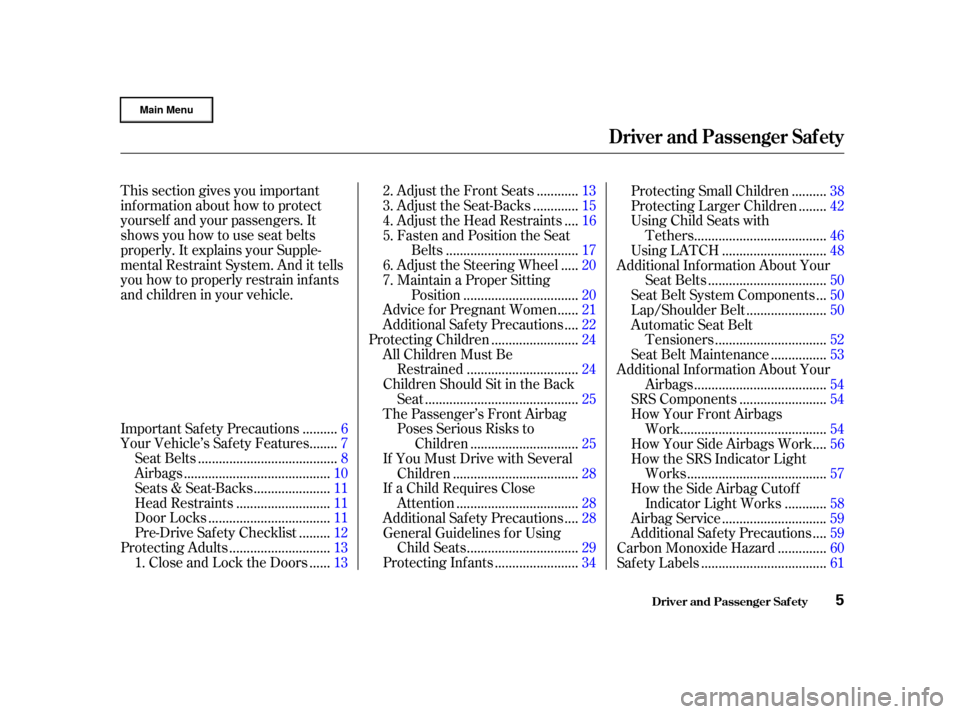
This section gives you important
inf ormation about how to protect
yourself and your passengers. It
shows you how to use seat belts
properly. It explains your Supple-
mental Restraint System. And it tells
you how to properly restrain inf ants
and children in your vehicle..........
Important Safety Precautions . 6
.......
Your Vehicle’s Saf ety Features . 7
.......................................
Seat Belts .8
.........................................
Airbags .10
.....................
Seats & Seat-Backs .11
..........................
Head Restraints .11
..................................
Door Locks .11
........
Pre-Drive Saf ety Checklist . 12
............................
Protecting Adults .13
.....
1. Close and Lock the Doors . 13 ...........
2. Adjust the Front Seats . 13
............
3. Adjust the Seat-Backs . 15
...
4. Adjust the Head Restraints . 16
5. Fasten and Position the Seat .....................................
Belts .17
....
6. Adjust the Steering Wheel . 20
7. Maintain a Proper Sitting ................................
Position .20
.....
Advice f or Pregnant Women . 21
...
Additional Safety Precautions . 22
........................
Protecting Children .24
All Children Must Be ...............................
Restrained .24
Children Should Sit in the Back ...........................................
Seat .25
The Passenger’s Front Airbag Poses Serious Risks to ..............................
Children .25
If You Must Drive with Several ...................................
Children .28
If a Child Requires Close ..................................
Attention .28
...
Additional Safety Precautions . 28
General Guidelines f or Using ...............................
Child Seats .29
.......................
Protecting Inf ants .34 .........
Protecting Small Children . 38
.......
Protecting Larger Children . 42
Using Child Seats with .....................................
Tethers .46
.............................
Using LATCH .48
Additional Inf ormation About Your .................................
Seat Belts .50
..
Seat Belt System Components . 50
......................
Lap/Shoulder Belt .50
Automatic Seat Belt ...............................
Tensioners .52
...............
Seat Belt Maintenance . 53
Additional Inf ormation About Your .....................................
Airbags .54
........................
SRS Components .54
How Your Front Airbags .........................................
Work .54
...
How Your Side Airbags Work . 56
How the SRS Indicator Light .......................................
Works .57
How the Side Airbag Cutof f ...........
Indicator Light Works . 58
.............................
Airbag Service .59
...
Additional Safety Precautions . 59
.............
Carbon Monoxide Hazard . 60
...................................
Saf ety Labels .61
Driver and Passenger Saf ety
Driver and Passenger Saf ety5
Page 14 of 372
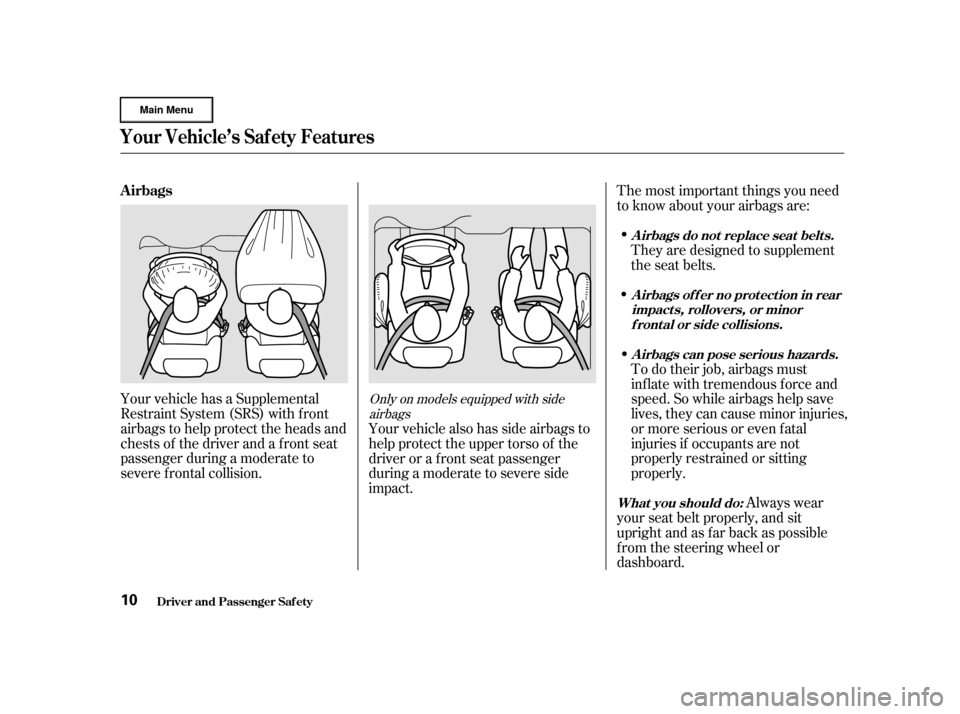
The most important things you need
to know about your airbags are:Always wear
your seat belt properly, and sit
upright and as f ar back as possible
f rom the steering wheel or
dashboard. To do their job, airbags must
inf late with tremendous f orce and
speed. So while airbags help save
lives, they can cause minor injuries,
or more serious or even fatal
injuries if occupants are not
properly restrained or sitting
properly. They are designed to supplement
the seat belts.
Your vehicle has a Supplemental
Restraint System (SRS) with f ront
airbags to help protect the heads and
chests of the driver and a front seat
passenger during a moderate to
severe f rontal collision. Your vehicle also has side airbags to
help protect the upper torso of the
driver or a f ront seat passenger
during a moderate to severe side
impact.
Only on models equipped with side
airbags
Airbags
Driver and Passenger Saf ety
What you should do:
Airbags can pose serious hazards.
A irbags of f er no prot ect ion in rear
impact s, rollovers, or minorf ront al or side collisions.
Airbags do not replace seat belts.
Your Vehicle’s Saf ety Features
10
Page 26 of 372

All passengers
must sit in locked, upright seats
andbeproperlyrestrainedbyseat
belts.
A passenger who is not
wearing a seat belt during a crash
or emergency stop can be thrown
against the inside of the vehicle,
against other occupants, or out of
the vehicle. If they do, they
could be very seriously injured in a
crash.
Devices intended to improve
occupant comf ort or reposition the
shoulder part of a seat belt can
severely compromise the
protective capability of the seat
belt and increase the chance of
serious injury in a crash. Carrying hard or sharp
objects on your lap, or driving with
a pipe or other sharp object in
your mouth, can result in injuries
if your f ront airbag inf lates.
Any object
attached to or placed on the covers
marked ‘‘SRS AIRBAG’’ in the
center of the steering wheel and
on top of the dashboard could
interf ere with the proper operation
of the airbags. Or, if the airbags
inf late, the objects could be
propelled inside the vehicle and
hurt someone.
Protecting Adults
Driver and Passenger Saf ety
Additional Saf ety Precautions
Never let passengers ride in t he
cargo area or on t op of a f olded-down back seat .
Passengers should not st and up orchange seats while the vehicle ismoving. T wo people should never use t he
same seat belt .
Do not put any accessories on seatbelts. Do not place hard or sharp object s
bet ween yourself and a f rontairbag.
Do not at t ach or place object s onthe f ront airbag covers.
22
Page 56 of 372
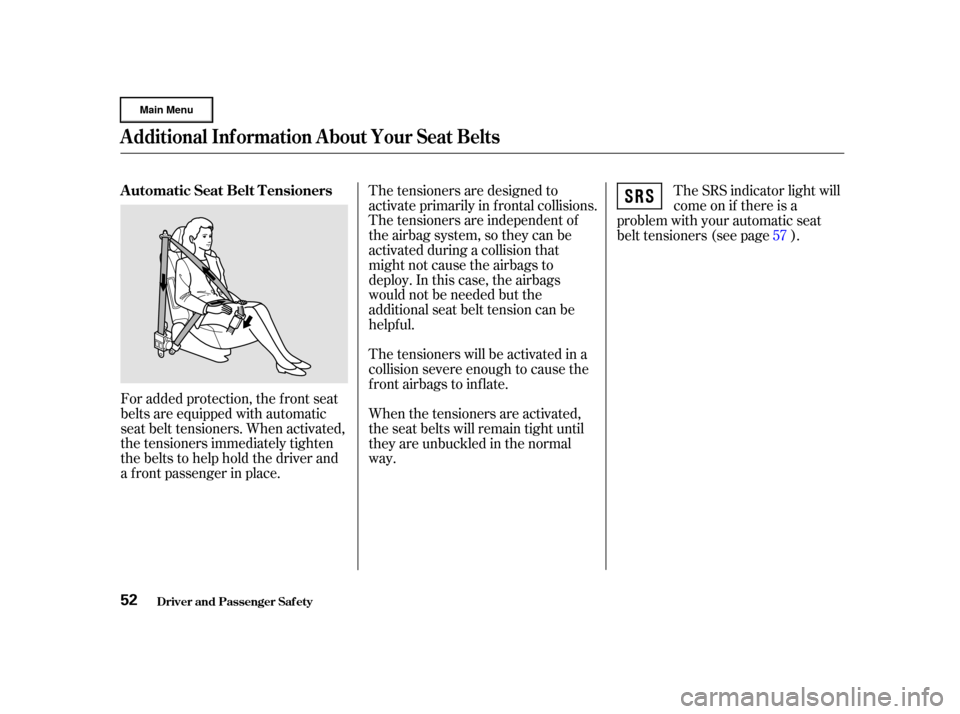
For added protection, the f ront seat
belts are equipped with automatic
seat belt tensioners. When activated,
the tensioners immediately tighten
the belts to help hold the driver and
a f ront passenger in place.The tensioners are designed to
activate primarily in f rontal collisions.
The tensioners are independent of
the airbag system, so they can be
activated during a collision that
might not cause the airbags to
deploy. In this case, the airbags
would not be needed but the
additional seat belt tension can be
helpf ul.
The tensioners will be activated in a
collision severe enough to cause the
f ront airbags to inf late.
When the tensioners are activated,
the seat belts will remain tight until
they are unbuckled in the normal
way.
The SRS indicator light will
come on if there is a
problem with your automatic seat
belt tensioners (see page ). 57
Additional Inf ormation About Your Seat Belts
Driver and Passenger Saf ety
A utomatic Seat Belt T ensioners
52
Page 58 of 372
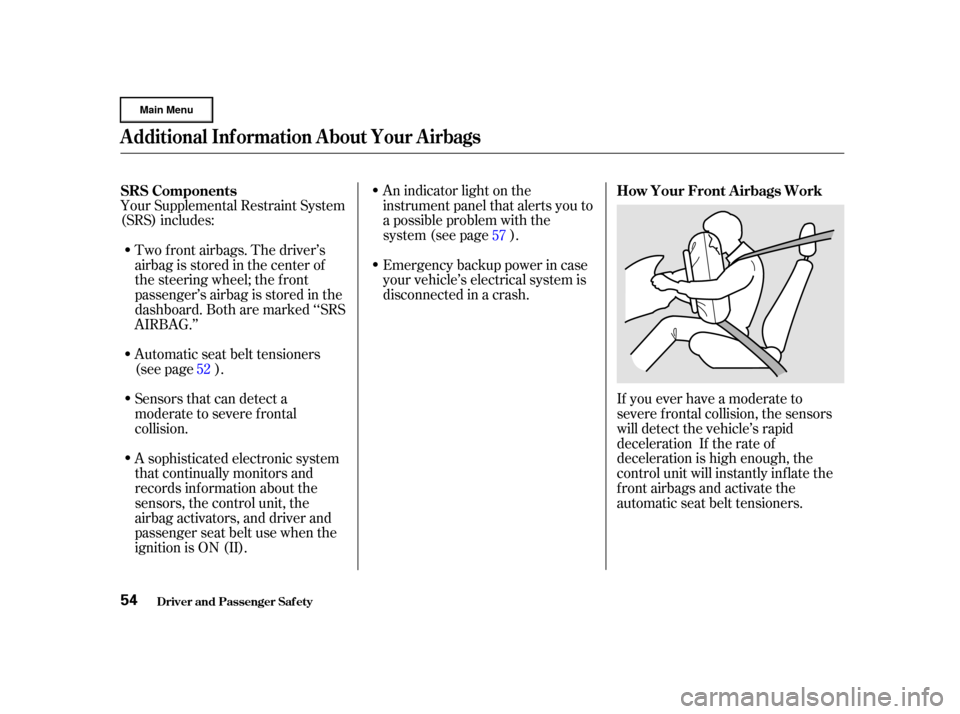
Your Supplemental Restraint System
(SRS) includes:An indicator light on the
instrument panel that alerts you to
a possible problem with the
system (see page ).
Emergency backup power in case
your vehicle’s electrical system is
disconnected in a crash.
Two f ront airbags. The driver’s
airbag is stored in the center of
the steering wheel; the f ront
passenger’sairbagisstoredinthe
dashboard. Both are marked ‘‘SRS
AIRBAG.’’
Automatic seat belt tensioners
(see page ).
Sensors that can detect a
moderate to severe frontal
collision.
If you ever have a moderate to
severe f rontal collision, the sensors
will detect the vehicle’s rapid
deceleration If the rate of
deceleration is high enough, the
control unit will instantly inf late the
front airbags and activate the
automatic seat belt tensioners.
A sophisticated electronic system
that continually monitors and
records inf ormation about the
sensors, the control unit, the
airbag activators, and driver and
passenger seat belt use when the
ignition is ON (II). 52
57
SRS Components
How Your Front A irbags Work
Additional Inf ormation About Your Airbags
Driver and Passenger Saf ety54
Page 59 of 372
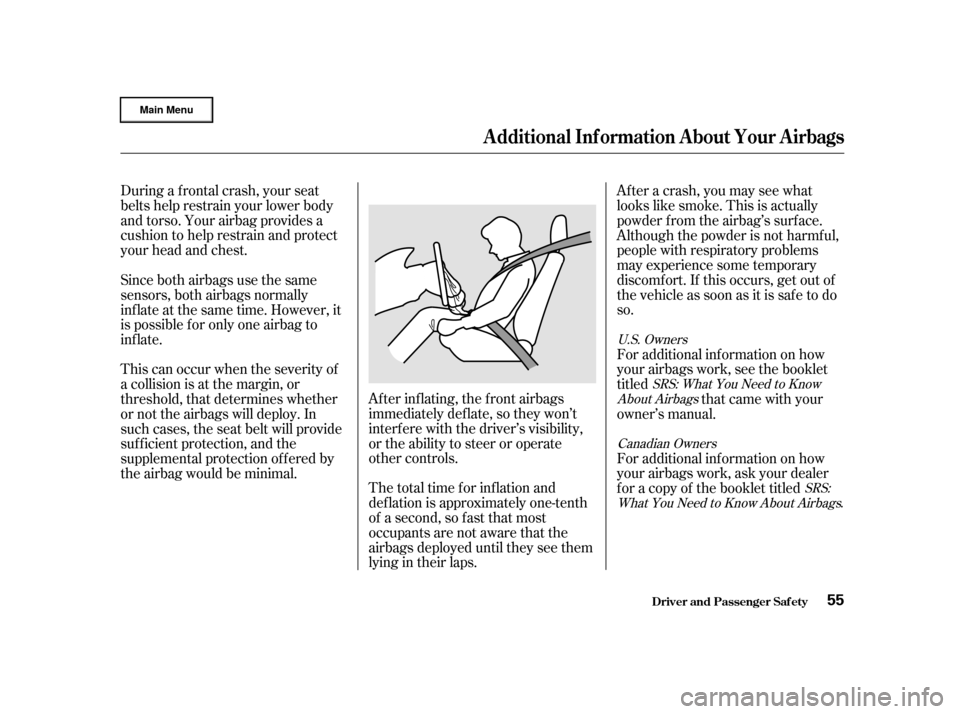
The total time for inflation and
def lation is approximately one-tenth
of a second, so f ast that most
occupants are not aware that the
airbags deployed until they see them
lying in their laps.
During a f rontal crash, your seat
belts help restrain your lower body
and torso. Your airbag provides a
cushion to help restrain and protect
your head and chest.
Af ter inf lating, the f ront airbags
immediately def late, so they won’t
interf ere with the driver’s visibility,
or the ability to steer or operate
other controls.After a crash, you may see what
looks like smoke. This is actually
powder f rom the airbag’s surf ace.
Although the powder is not harmf ul,
people with respiratory problems
may experience some temporary
discomf ort. If this occurs, get out of
the vehicle as soon as it is saf e to do
so.
For additional information on how
your airbags work, ask your dealer
f or a copy of the booklet titled For additional information on how
your airbags work, see the booklet
titled
that came with your
owner’s manual.
Since both airbags use the same
sensors, both airbags normally
inf late at the same time. However, it
is possible f or only one airbag to
inf late.
This can occur when the severity of
a collision is at the margin, or
threshold, that determines whether
or not the airbags will deploy. In
such cases, the seat belt will provide
suf f icient protection, and the
supplemental protection of f ered by
the airbag would be minimal.SRS:
What You Need to Know About Airbags
.
SRS: What You Need to Know
About Airbags
U.S. Owners
Canadian Owners
Additional Inf ormation About Your Airbags
Driver and Passenger Saf ety55
Page 61 of 372

If the light comes on at any other
time, or does not come on at all, you
should have the system checked by
your dealer. For example:If the SRS indicator light does not
come on after you turn the ignition
ON (II).
If the light stays on after the
engine starts.
If the light comes on or f lashes on
andoff whileyoudrive.
The SRS indicator light
alerts you to a potential
problem with your f ront airbags and
automatic seat belt tensioners.
On models with side airbags, this
light will also alert you to a potential
problem with your side airbags or
passenger’s side airbag automatic
cutof f system (see page ).
When you turn the ignition ON (II),
this indicator will light brief ly then
go out. This tells you that the system
is working properly. If you see any of these indications,
your f ront or side airbags may not
deploy, your passenger’s side airbag
automatic cutoff system may not
work properly, or your seat belt
tensioners may not work when you
need them. See your Honda dealer
as soon as possible.
58
How the SRS Indicator L ight
Works
Additional Inf ormation About Your Airbags
Driver and Passenger Saf ety57
Ignoring the SRS indicator light
can result in serious injury or
death if the airbags, cutoff
system, or tensioners do not
work properly.
Have your vehicle checked by a
dealer as soon as possible if
theSRSlightalertsyoutoa
potential problem.
Page 63 of 372

Together, airbags and
seat belts provide the best
protection.
Tampering could cause
the airbags to deploy, possibly
causing very serious injury. See page f or f urther inf ormation
and precautions relating to your
airbags.
If rain or spilled water
soaks into a seat-back, it can
prevent the side airbag system
f rom working properly. Improperly
replacing or covering f ront seat-
back covers can prevent your side
airbags f rom inf lating during a
collision.
Any
airbag that has deployed must be
replaced along with the control
unit, automatic seat belt
tensioners, and other related parts.
Do not try to remove or replace
anyairbagbyyourself.Thismust
be done by a Honda dealer or a
knowledgeable body shop.
Your f ront and side airbag systems
(if equipped) are virtually
maintenance-f ree, and there are no
parts you can saf ely service.
However, you must have your
vehicle serviced if:
Take your vehicle to
an authorized Honda dealer as
soon as possible. If you ignore this
indication, the airbags might not
inf late when you need them. 192
Airbag Service
Additional Saf ety Precautions
Donotattempttodeactivateyour
airbags.
Do not t amper wit h airbagcomponent s or wiring f or anyreason.
Do not expose t he f ront seat -backsto water. Do not cover or replace f ront seat -
back covers wit hout consult ing aHonda dealer.
Your airbags ever inf late.
T he SRS indicat or light alert s yout o a problem.
Additional Inf ormation About Your Airbags
Driver and Passenger Saf ety59
Page 195 of 372

Modif ying your vehicle, or installing
some non-Honda accessories, can
make your vehicle unsaf e. Bef ore
you make any modif ications or add
anyaccessories,besuretoreadthe
f ollowing inf ormation.When properly installed, cellular
phones, alarms, two-way radios, and
low-powered audio systems should
not interf ere with your vehicle’s
computer-controlled systems, such
as the SRS and anti-lock brake
system.
Your dealer has Honda accessories
that allow you to personalize your
vehicle. These accessories have
been designed and approved f or your
vehicle, and are covered by warranty.
Non-Honda accessories are usually
designed f or universal applications.
Although aftermarket accessories
may f it on your vehicle, they may not
meet f actory specif ications, and
could adversely af f ect your vehicle’s
handling and stability. (See
‘‘Modif ications’’ on page f or
additional inf ormation.)
If possible, have your dealer inspect
the f inal installation. Have the installer contact your
Honda dealer f or assistance bef ore
installing any electronic accessory. Be sure electronic accessories do
not overload electrical circuits
(see page ). Make sure the accessory does not
obscure any lights, or interf ere
with proper vehicle operation or
perf ormance.
Bef ore installing any accessory: However, if electronic accessories
are improperly installed, or exceed
your vehicle’s electrical system
capacity, they can interf ere with the
operation of your vehicle, or even
cause the airbags to deploy.
192 331
A ccessories
A ccessories and Modif ications
Bef ore Driving191
Improper accessories or
modifications can affect your
vehicle’s handling, stability and
performance, and cause a
crash in which you can be hurt
or killed.
Follow all instructions in this
owner’s manual regarding
accessories and modifications.
Page 196 of 372

Do not remove any original
equipment or modif y your vehicle in
any way that would alter its design or
operation. This could make your
vehicle unsaf e and illegal to drive.
Such modif ications can adversely
af f ect handling, and interf ere with
the operation of the vehicle’s anti-
lock brakes and other systems.In addition, any modif ications that
decrease ground clearance increase
the chance of undercarriage parts
striking a curb, speed bump, or other
raised object, which could cause
your airbags to deploy.
Do not modif y your steering wheel
or any other part of your
Supplemental Restraint System.
Modif ications could make the
system inef f ective.
For example, do not make any
modif ications that would change the
ride height of your vehicle, or install
wheels and tires with a dif f erent
overall diameter.
Any object
attached to or placed on the covers
marked ‘‘SRS AIRBAG,’’ in the
center of the steering wheel and
on top of the dashboard, could
interf ere with the proper operation
of the airbags. Or, if the airbags
inf late, the objects could be
propelled inside the vehicle and
hurt someone. Covering the outside edge of a
f ront seat-back, with a non-Honda
seat cover for example, could
prevent the airbag from inflating
properly.
If a side airbag
inflates,acupholderorotherhard
object attached on or near the
door could be propelled inside the
vehicle and hurt someone.
Only on models equipped with side
airbagsModif ications
Additional Saf ety Precautions
Do not at t ach or place object s onthe f ront airbag covers. Do not place any object s over t he
outsideedgeof afront seat-back.
Do not at t ach hard object s on or
near a f ront door.
A ccessories and Modif ications
Bef ore Driving192